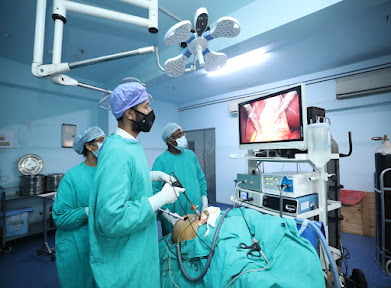BIMAST is a premier training institute in India offering specialized medical training courses and fellowship program to doctors in certain medical disciplines -
Top Laparoscopic Surgery in India
What is Laparoscopic Surgery ?
Laparoscopic surgery is minimally invasive surgical surgery carried out through a small incision. With the aid of a device called a laparoscope, which contains a tiny video camera and light on the end, it is feasible. The abdominal cavity is initially filled with carbon dioxide gas to create a place for operating and seeing. A 5mm incision is made, and the telescope is then inserted into the abdominal cavity. The surgeon or medical professional can view a video monitor within the abdominal cavity through it. Little incisions are used to introduce additional functioning ports, and surgery is completed.
When non-invasive procedures fail to diagnose a disorder, laparoscopy is utilized for diagnostics. Surgery is carried out through small incisions, which speeds up postoperative patient recovery, lessens blood loss and pain, and dramatically improves cosmetics.
Diagnosis options are offered through laparoscopy for Pelvic inflammatory disease (PID), Endometriosis, Ectopic pregnancy, Ovarian cyst, Fibroids, Female infertility, Undescended testicles, Appendicitis, Unexplained abdominal pain, Liver cancer, Pancreatic cancer , Ovarian cancer, Bile duct cancer, Gallbladder cancer.
Top Laparoscopic Surgery in India
Introduction
One of the most popular laparoscopic procedures performed by general surgeons worldwide is the laparoscopic cholecystectomy (LC). Estimating the risk of conversion or the intricacy of the treatment in advance is just one of many variables that must be taken into account when planning a laparoscopic surgery. The objective of our study was to assess a number of risk factors and use a scoring system to determine the complexity and extent of the operation prior to surgery.
Materials
This prospective study was carried out in Jaipur, India, at the neighboring Dr. Ram Manohar BIMAST(Bhandari Hospital) and the Department of Surgery at BIMAST(Bhandari Hospital) Medical College. The preoperative scoring procedure took into account the patient's age, gender, history of hospitalizations, obesity, scars from earlier abdominal surgeries, palpable gall bladders, thick gall bladder walls, pericholecystic collections, and impacted stones. In total, 210 participants participated in the trial.
Results
We found that previous hospitalization, palpable gall bladder, impacted stones, and gall bladder wall thickness statistically significantly influenced the chance of a challenging laparoscopic cholecystectomy. The results showed that the sensitivity and specificity of this preoperative scoring system were 95.74% and 73.68%, respectively. This scoring method obtained 90% and 88% positive prediction scores for simple and difficult examples, respectively. the 0.86 ROC curve's ROC area. It was found that the conversion rate from laparoscopic to open cholecystectomy was 4.28%.
Conclusion
High-risk patients can discover in advance how likely they are to convert, providing them the chance to make plans in accordance, with the aid of accurate prediction. On the other hand, surgeons might also need to carefully prepare the people and timing of the procedure. Surgeons can also be aware of the potential complications that could arise in high risk patients.



Comments
Post a Comment